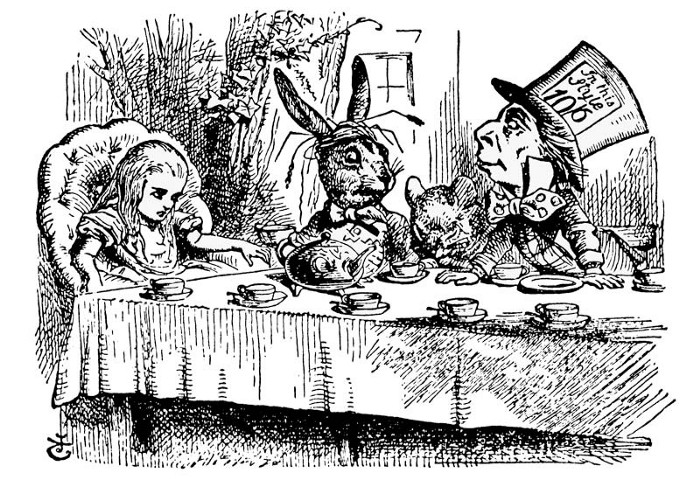Alice tries to enjoy the Mad Hatter’s Tea Party, but she just doesn’t know why a raven is like a writing-desk. Who can blame her?
At-Home Activity: Write your own nonsense poem!
By Anjali Shastry
The opening lines of Lewis Carroll’s Jabberwocky are captivating, scene-setting, and memorable.
’Twas brillig, and the slithy toves
Did gyre and gimble in the wabe:
All mimsy were the borogoves,
And the mome raths outgrabe.
It’s also hot nonsense. Literary nonsense, to be precise.
This is a genre that Carroll, Dr. Seuss, and John Lennon have made famous. Literary nonsense tickles our intellectual funny bones; it is gibberish, it is parody, it is satire. But it is also a distinct art form that allows us to bend our thought processes and entertain the impossible, the silly and the humorous. Most literary nonsense works are devoid of obvious meaning, but delight us with their ability to encourage us to play with words, sounds, and new ideas.
For example:
Mad Hatter: “Why is a raven like a writing-desk?”
“Have you guessed the riddle yet?” the Hatter said, turning to Alice again.
“No, I give it up,” Alice replied: “What’s the answer?”
“I haven’t the slightest idea,” said the Hatter.
Once you put aside that very human need to find meaning in everything, you can relax and enjoy some nonsense of the literary variety. As Dr. Seuss said, “I like nonsense, it wakes up the brain cells.”
There is no age group better suited to appreciate literary nonsense and indulge in the art form than children. So let’s wake up our brain cells together with this poetry activity!
At-Home Activity: Write a Literary Nonsense Poem!
Step 1: Be inspired
- Begin by reading a few literary nonsense poems or songs to spark your little ones’ imaginations. Perhaps enjoy a family dramatic reading of Jabberwocky (full text at the bottom of this article), play The Beatles’ Yellow Submarine, or sing The Name Game by Shirley Ellis (you know that song— “Shirley, Shirley, Bo-ber-ley, bo-na-na fanna fo-fer-ley, fee fi mo-mer-ley, Shirley!) at the top of your lungs! What gets the creative juices flowing? What do you like? What seems weird?
- What are some books, movies, and characters that you like? Do any of them seem silly? What are some funny things that happen? What would you like to see happen?
- Take a walk around your house or your neighborhood. What seems absurd? Can you make it wackier in your head? Can you write it down?
Step 2: Start writing
- Start giving your most nonsensical thoughts some words. Write down your stories! It doesn’t need to rhyme.
- Is the English language just not cutting it for you? Mix it up! Break out words from other languages. Mix and match. Whoa, there’s no language on Earth that works for what you’re trying to say? That’s fine, make up your own! Dr. Seuss did, Lewis Carroll did, even Shakespeare did. You are in good company.
- Explore different poetry formats. Write a haiku. Give your words a literal shape and write a diamante (diamond-shaped poem). The possibilities are endless.
Step 3: Make some art
- Once you have your nonsense poem written down, draw a picture to accompany it! Bring your words to life and show off the imaginative world you have conjured.
Congratulations, you have your own nonsense poem! But nonsense is not restricted to poetry — expand to prose and write a literary nonsense short story, or even a novel. Draw some nonsense art. Make up nonsense worlds. Dr. Seuss was right, there is no better way to wake up your brain!
Jabberwocky is a delightful poem to read aloud, and have read aloud to you. Enjoy actor Benedict Cumberbatch doing a dramatic reading of the classic literary nonsense poem.
Jabberwocky
By Lewis Carroll
’Twas brillig, and the slithy toves
Did gyre and gimble in the wabe:
All mimsy were the borogoves,
And the mome raths outgrabe.“Beware the Jabberwock, my son!
The jaws that bite, the claws that catch!
Beware the Jubjub bird, and shun
The frumious Bandersnatch!”He took his vorpal sword in hand;
Long time the manxome foe he sought —
So rested he by the Tumtum tree
And stood awhile in thought.And, as in uffish thought he stood,
The Jabberwock, with eyes of flame,
Came whiffling through the tulgey wood,
And burbled as it came!One, two! One, two! And through and through
The vorpal blade went snicker-snack!
He left it dead, and with its head
He went galumphing back.“And hast thou slain the Jabberwock?
Come to my arms, my beamish boy!
O frabjous day! Callooh! Callay!”
He chortled in his joy.’Twas brillig, and the slithy toves
Did gyre and gimble in the wabe:
All mimsy were the borogoves,
And the mome raths outgrabe.

